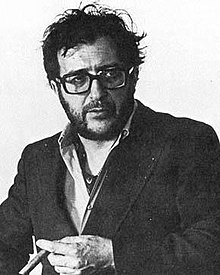卢恰诺·贝里奥
| 卢恰诺·贝里奥 Luciano Berio | |
|---|---|
 | |
| 出生 | 1925年10月24日 因佩里亚 |
| 逝世 | 2003年5月27日(77岁) 罗马 |
| 国籍 | 意大利 |
| 知名作品 | 独奏曲《模进》,人声和乐队《交响曲》、女声、竖琴和打击乐《圆圈》,歌剧《国王倾听》 |
| 所属时期/乐派 | 20世纪 |
| 擅长类型 | 舞台音乐,声乐曲,各种实验性器乐曲,电子音乐 |
师从 | |
学生/受影响人物 | |
卢恰诺·贝里奥(义大利语:Luciano Berio,1925年10月24日—2003年5月27日),意大利作曲家。曾与马代尔纳共建电子音乐实验室。后来应米约之邀赴美国加州任教。返欧后在巴黎等地从事音乐研究。2003年在罗马去世。
贝里奥是20世纪下半叶很重要的一位先锋派作曲家,他的音乐风格结合了序列主义、电子音乐、机遇音乐、以及“拼贴”手法,作品中常有摘用前人名作的例子。同时他也没有远离意大利的歌剧传统,曾改编过很多前辈大师的作品。他续完的新版本普契尼《图兰朵》于2002年首演。[1]
生平
[编辑]1925年,贝里奥出生于意大利利古里亚海岸的小镇奥内利亚(如今属于因佩里亚城)。他的祖父和父亲都是管风琴演奏家,贝里奥自幼随他们学习钢琴。在第二次世界大战期间,他被征召入伍,但他在第一天学习如何使用枪支时便伤了手,随后在军事医院度过了一段时光。

Following the war, Berio studied at the Milan Conservatory under Giulio Cesare Paribeni and Giorgio Federico Ghedini. 由于手部受伤,他无法继续学习钢琴,因此他转而专注于作曲。In 1947, he had the first public performance of one of his works, a suite for piano. Berio made a living at this time by accompanying singing classes, and it was in doing this that he met the American mezzo-soprano Cathy Berberian, whom he married shortly after graduating (they divorced in 1964). They had one daughter, Cristina Berio (born in 1953). Berio wrote a number of pieces that exploited her distinctive voice.
1952年,贝里奥前往美国坦格活德跟随路易吉·达拉皮科拉学习,并从他那里对序列主义产生了兴趣。随后他参加了达姆施塔特的新音乐国际暑期课程(德语:Internationale Ferienkurse für Neue Musik),并在那里遇到了皮埃尔·布莱兹、卡尔海因茨·施托克豪森、利盖蒂·捷尔吉和毛里西奥·卡赫尔。他开始对电子音乐产生了兴趣,于1955年和布鲁诺·马代尔纳在米兰合作成立了一所名为Studio di fonologia musicale的电子音乐工作室。他邀请了不少重要的作曲家前往那里工作,包括亨利·布瑟和约翰·凯奇。此外,他还创办了一本名为《Incontri Musicali》的电子音乐学术期刊。
In 1960, Berio returned to Tanglewood, this time as Composer in Residence, and in 1962, on an invitation from Darius Milhaud, took a teaching post at Mills College in Oakland, California. From 1960 to 1962, Berio also taught at the Dartington International Summer School. In 1965, he began to teach at the Juilliard School, and there he founded the Juilliard Ensemble, a group dedicated to performances of contemporary music. 1966年他再次结婚,这次是和著名的科学哲学家Susan Oyama。他们于1972年离婚。他的学生包括路易斯·安德里森、Noah Creshevsky、Steven Gellman、Dina Koston、斯蒂夫·莱奇、Luca Francesconi、Giulio Castagnoli、Flavio Emilio Scogna、William Schimmel、死之华乐队的菲尔·莱什。
在这一时期,贝里奥一直在稳定地创作并建立声誉,他通过《Laborintus II》获得了1966年的意大利奖(义大利语:Prix Italia)。这部作品为声音、乐器和录音带创作,文本由诗人埃多阿多·桑圭内蒂(Edoardo Sanguineti)提供,是法国电视台为纪念但丁诞辰700周年委约创作的。[2] His reputation was strengthened when his Sinfonia was premiered in 1968. 1972年,贝里奥返回了意大利。在1974年至1980年间,他在巴黎担任IRCAM电子声学部门的主任。他在1977年与音乐学家Talia Pecker结婚。
In 1987, he opened Tempo Reale, a centre for musical research and production based in Florence. In 1988, he was made an Honorary Member of the Royal Academy of Music, London.[3] The following year, he received the Ernst von Siemens Music Prize. He was elected a Foreign Honorary Member of the American Academy of Arts and Sciences in 1994.[4] The same year, he became Distinguished Composer in Residence at Harvard University, remaining there until 2000. 自1993年至1994年,他受邀前往哈佛主讲诺顿讲座,讲座以《记忆未来》(英语:Remembering the Future)为标题,内容收录于2006年出版的同名书籍。2000年他成为了罗马圣塞西莉亚音乐学院的主席兼总管。
贝里奥始终活跃在指挥和作曲事业上,直至2003年病逝于罗马的一家医院,得年77岁。他是无神论者。[5]
他以幽默感著称。他曾在美国的一所夏季学校举办了一场为期两小时的研讨会,分析贝多芬的第七交响曲,证明这是一部极具天才的作品。第二天,他又举办了另一场为期两小时的研讨会,面无表情地讲解为何这部作品充满着致命缺陷、创作上走入了死胡同。[6]
参见
[编辑]参考资料
[编辑]- ^ Puccini/Berio: Turandot, Act III. [2009-08-29]. (原始内容存档于2007-07-05).
- ^ Laborintus II (author's note). Centro Studi Luciano Berio.
- ^ Luciano Berio, London Sinfonietta. London Sinfonietta. [14 October 2009]. (原始内容存档于12 July 2010).
- ^ Book of Members, 1780–2010: Chapter B (PDF). American Academy of Arts and Sciences. [16 June 2011].
- ^ Giovanni Arledler, La musica e la Bibbia, "La Civiltà Cattolica" no. 3372, 15 December 1990, pp. 593–594.
- ^ Butler, Martin. Luciano Berio: The Godfather. The Independent. 11 April 2004 [8 November 2018].
